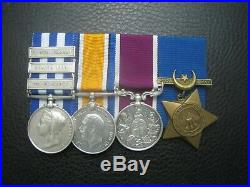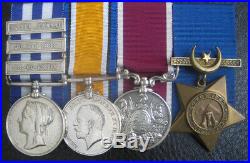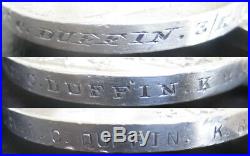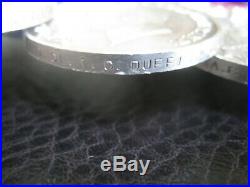THE EGYPT AND SUDAN CASUALTY GROUP TO A LONG SERVING REGIMENTAL SERGEANT-MAJOR OF THE KING’S ROYAL RIFLE CORPS, WHO WAS SEVERELY WOUNDED AT THE. OF TAMAAI ON 13 MARCH 1884. ALSO SERVED IN THE 1. BOER WAR AND EGYPT 1882 CAMPAIGN. EGYPT AND SUDAN 1882-9, DATED REVERSE, 3 CLASPS, TEL-EL-KEBIR, SUAKIN 1884, EL-TEB_TAMAAI 4220. BRITISH WAR MEDAL 1914-20 R-5733 W. MIL:S:MAJ: C. KHEDIVE’S STAR 1882, unnamed as issued. Charles Duffin , aged 18, from Hythe, Kent, enlisted into the 76. Dec 1879, he transferred to the 3. Kings Royal Rifle Corps. He was promoted Corporal in June 1882, Lance Sergeant June 1885, Sergeant June 1886, Colour Sergeant in August 1886, Sergeant Major (Militia) Oct 1896 and Sergeant Major (WO) on 1. Nov 1880 until 22. Feb 1882, therefore taking part in the 1. Boer War, the 3/60. Being noted in particular for the battle of. He further served in. Feb 1882 until July 1882. July 1882 until May 1884 ; including the. He further served in Cyrus and. Feb 1885 until Dec 1891, the rest of his service being at home. Duffin is noted as being severely wounded in action at the battle of Tamaai (gunshot wound to left thigh). Here he was one of 214 British casualties that day and one of just 5 to the Rifle Corps. For the British, this was the costliest in casualties of all the battles of the. A local newspaper also notes. Sergeant Major Duffin, now aged 50, was discharged at Woolwich on 24. His conduct unsurprisingly, was noted as exemplary, his service 32 years and confirms all awards/clasps. At the outbreak of WW1, Duffin reenlisted with the Rifles for a year on 10. October 1914, though in the event he was not discharged until 18. June 1918, by which time he was Regimental Sergeant Major. Reason given; age and defective memory. His entire service was at home during the Great War and was. Entitled to the BWM only (MIC confirms). Condition GF/VF a little polished and usual pitting on. Last part of naming of Regt on 1. Two from largely lost from contact with Star, rest of naming on these two and BWM fine; areas effected noted as. A good group to a long serving Sergeant Major of the Rifle Corps who would have seen a great deal of action. Additionally a very scarce casualty to the Rifles for the battle of Tamaai. The following is from A Brief History of the Regiment. The 3rd Battalion, under Lieutenant-Colonel Cromer Ashburnham, remained in South Africa, and was quartered at Pietermaritzburg, when in January, 1881, the Boers, under Joubert, invaded Natal. Major-General Sir George Colley, the High Commissioner and Commander. In-Chief, having assembled at. A small force, which included the 3rd Battalion, advanced and attacked the Boers on the 28th in position at Laing’s Nek. Battalion in part covered the left flank, and in part formed a reserve to the assaulting column. The attack was repulsed with heavy loss, and the Battalion covered the retreat, but did not lose many men. On the 25th of January the 2nd Battalion arrived from. In a state of the highest efficiency after its successful experience in the Afghan War. It marched forthwith to join headquarters at. Where it remained until the armistice in March. 8th, 1881, The Boers, as a result of their victory at Laing’s Nek, made a desperate eriort to sever the communications between Coney’s force at Mount Prospect, and the advanced base at. The General accordingly took prompt steps to avert this catastrophe, and thus. It came about that on the 8th of February was fought on the. An action as glorious as any in the history of the 60th. Colley, with two 9-pounder R. Guns, thirty-eight men of the Mounted Infantry, and five companies of the 3rd Battalion, under Ashburnham, marched early on the 8th from Prospect upon Newcastle, crossed the Ingogo River, and, on ascending the heights beyond, was attacked from all sides shortly before noon. The British position was a plateau covered with short grass, rocks, and boulders; whereas the kloofs and slopes occupied by the Boers were also not only strewn with rocks, but overgrown with. Long grass, which being three and four feet high afforded excellent cover. The troops, though completely surrounded, maintained the fight for nearly seven hours, until at last, in the gloom of approaching night and a heavy thunderstorm, the fire ceased and the enemy sullenly withdrew. The Battalion had lost five out of thirteen officers, and 119 out of 295 other ranks; of I Company only one officer and thirteen men were left, but nowhere had the enemy gained ground. The survivors, without food or water, and with ammunition running short. But with courage and discipline still unshaken, then faced the last ordeal of that long day. Little could be done for the wounded, except to collect and leave them with the chaplain, the doctor, and a few other non-combatants; and then, in drenching rain and darkness only broken by flashes of lightning, the few remaining horses were hooked into the guns, and the little force moved silently across the veldt to the river, which was in flood, and had to be forded breast high. So slippery was the ground from the rain that the horses could not draw the guns ; this for the last few miles was done by the Riflemen. At 8.30 a. Prospect Camp was reached after a peculiarly strenuous test of the courage and endurance of the troops. “The conduct of all ranks throughout this trying day was admirable, ” wrote Sir George Colley in his despatch. The comparatively young soldiers of the 60th Rifles behaved with the steadiness and coolness of veterans. At all times perfectly in hand, they held or changed their ground as directed without hurry or confusion ; though under heavy fire, themselves fired steadily, husbanding their ammunition and at the end of the day, with sadly reduced numbers formed and moved off the ground with the most perfect steadiness and order; and, finally, after eighteen hours of continuous fatigue, readily and I cheerfully attached themselves to the guns, and I dragged them up the long hill from the Ingogo, when the horses were unable to do so. On the night of the 26th of February Sir George Colley decided to seize Majuba Hill by a night march Feb. A hazardous undertaking which was ably executed. The following day the Boers in three assaulting columns, covered by the rifle fire of their largely superior force. Carried the mountain with splendid gallantry, and completely defeated the small British force of 414 soldiers and sailors. Two companies of the 3rd Battalion were posted upon the lower spurs of the mountain, and with a third company sent out later with ammunition they covered. The retreat, but were only slightly engaged. The brave and accomplished Colley dauntless to the end died a soldier’s death upon the summit of the mountain, and deplorable indeed was the loss in officers and men of the force engaged. A peace insisted upon by the British Government brought this unhappy campaign to a close little to the satisfaction of the troops concerned. The 3rd Battalion, under Colonel Ashburnham, had been moved from. When the outbreak of hostilities in. Caused it to be despatched with the 38th Regiment to. On the 18th of July, shortly after the bombardment of. It landed while the city was still in flames, and formed part of the advanced force under Major-General Sir Archibald Alison. A portion of the Battalion took part with the Mounted Infantry, on the 22nd of July, in the first engagement of the campaign at Mallaha Junction, eight miles from. And again in the reconnaissance in force on. The 5th August near Ramleh. On August the 18th, upon the arrival of Sir Garnet Wolseley, it embarked for. And took part in the actions of Tel-el-Mahuta on the 25th, and Kassassin on the 9th of September, when the enemy, about 13,000 strong, was completely defeated. Ashburnham, which had been organised for the night. March of the 12th-13th September and the assault of the lines of Te-el-Kebir at daylight. The Brigade forming the support of the Highland Brigade closed up at the beginning of the battle as day began to dawn, and gave a timely assistance in the assault of the enemy’s lines. The Battalion in two lines pressed eagerly forward with its accustomed dash, and entered. The Egyptian works at about the centre of the position, where Major Cramer, second in Command, was wounded, and had his horse shot under him. After an ebb and flow of strenuous bayonet fighting the enemy gave way on all sides, and, suffering great losses, were. Broken and dispersed in headlong flight. Was captured, and the war ended, upon which the Battalion formed part of the army of occupation. In February, 1884, the Battalion, under Ashburnham, was ordered to Suakim, where it served in a Brigade under that distinguished Rifleman, Major- General Sir Redvers Buller, as part of General Sir Gerald Graham’s force. On the 29th of February it took part in the defeat of the Dervishes at El Teb, and on the 13th of March it was present at the critical battle of Tamai. The troops were in two squares, one under Sir Gerald Graham, commanding the force, the other under Buller. Graham’s square was broken, and in the confusion some of its men poured a volley into Buller’s, causing one face to run in. Sir Redvers at once rode outside the square, and, with great coolness, rallied his men. By restoring the formation he undoubtedly staved off a terrible disaster, for, had the square been really broken, nothing could have saved. This action ended the Campaign. PLEASE NOTE; If you have any questions and require more images please get in touch. SEE MY OTHER AUCTIONS FOR SIMILAR ITEMS. KEYWORDS: MEDAL MEDALS BOER EGYPT SUDAN ZULU AFGHANISTAN ASHANTEE SOUTH AFRICA KILLED WOUNDED 1879 1880 1881 1882 1884 1885 1899 PIRATES WW1 ROYAL NAVAL NAVY ARMY BRIGADE AWARD CAPTAIN COMMANDER LIEUTENANT OFFICER. NAPOLEONIC NAPOLEON 1793 NELSON WELLINGTON WATERLOO KILLED WOUNDED 1815 INDIAN MUTINY. The item “EGYPT SUDAN 1882-9 WW1 LSGC MEDAL GROUP WOUNDED TAMAAI SGT MAJOR RIFLE CORPS” is in sale since Friday, September 6, 2019. This item is in the category “Collectables\Militaria\19th Century (1800-1899)\Medals/ Ribbons”. The seller is “albatrosj1″ and is located in SCOTLAND. This item can be shipped worldwide.









